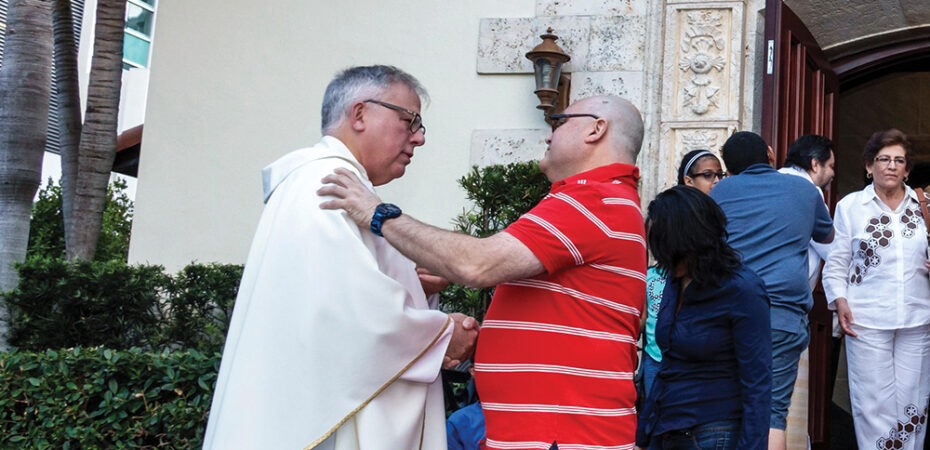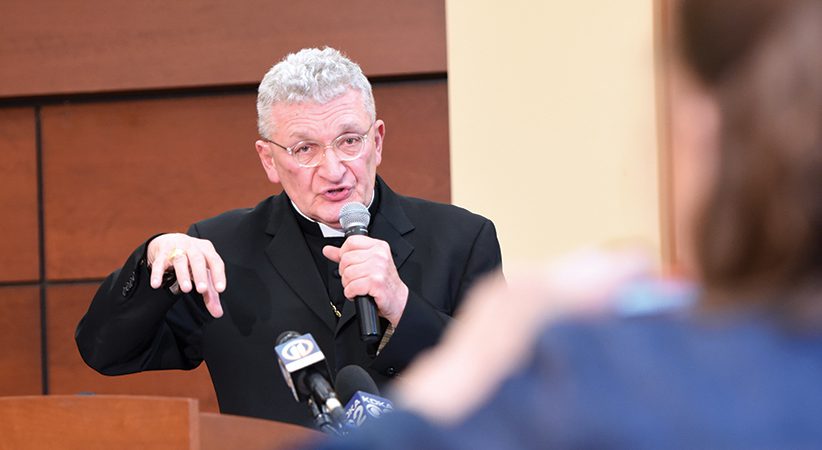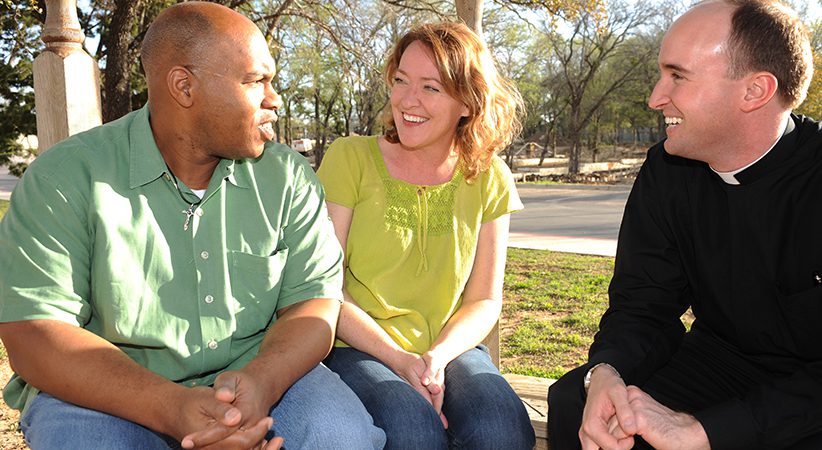Priests as Leaders
How to foster adaptive change
Dan R. Ebener 1
Change occurs without leadership, but leadership does not occur without change. In fact, it is precisely the change that occurs without leadership that demands the attention of leaders. These are the environmental changes in a world that demand that we adapt. Without adaptation, we fall into entropy. Organizations struggle and institutions die a slow death.
The world has changed, and is changing. It is becoming increasingly complex, interdependent, secular, multicultural and unpredictable. This causes uncertainty and chaos. It requires continuous learning and action. The status quo becomes the enemy. Organizations need to adapt to these global changes and to adopt a new approach to leadership.
The Church and the world are desperate for adaptive change, and that change can only be led, not managed. Generally, the technical work of an organization, such as bookkeeping, groundskeeping and information technology, is the work of management (all of which is important). However, in today’s world, the challenges we face are increasingly adaptive in nature, which means there are no easy answers. Adaptive issues require a change of hearts and minds, which requires leadership, not management.
…………………………………………………………………………………………………………………………………………………………
Exploring Leadership for the Greater Good
In Leadership for the Greater Good (Paulist Press, $24.95), authors Dan R. Ebener and Borna Jalšenjak provide a textbook that focuses on how leadership can be practiced by those with and without authority. The aim, of course, is to change the way people lead and manage.
The first part of the book describes the evolution of leadership in the 21st century. Originally a matter of telling people what to do, leadership has evolved into voluntary, interactive processes that move organizations toward adaptive change. It demands influential tactics that are less coercive and more engaging.
The second part of the book looks at the history of “leadership” theories.
The third part presents skills needed today in the practice of leadership. These include dialogical skill, emotional intelligence, leading adaptive change, conflict skills and strategic planning.
…………………………………………………………………………………………………………………………………………………………
Technical fixes are easier to apply and can (at best) provide a partial solution to most of our problems. For example, we have many technical fixes available to help control the coronavirus. However, it is changing people’s minds about wearing face masks, getting the vaccination and staying socially distanced that has proven to be the more difficult challenge.
When faced with a crisis, it is human nature to hope that a savior will come along. We look for that charismatic person with a clear vision of the future and the ability to articulate it. The reality is that this sort of leadership does not work. In the long run, the people become more compliant and less engaged. They expect that charismatic person to save the day for them. The result is less leadership from everyone else.
A changing world requires more adaptive leadership in the Church. This type of leadership can emerge from every direction — from the pulpit and the pews. We need clergy to step up and lead adaptive change, while also stepping back at times to create the space for leadership to emerge from others. We need laypeople to step up and lead, and, at times, the old guard needs to step back to create space for others to take the initiative.
No one is appointed, assigned or ordained as a leader. Leadership is an activity, not a position, rank or title. We become leaders when we practice the voluntary, interactive process that intends adaptive change. This is true for everyone, not just priests. We often assume that people who are in a position of authority are automatically leaders.
Those in authority have a lot to say about how much leadership is practiced. Their words and actions help create the structures and culture that determine to what extent leadership can take place. Less hierarchical structures can encourage leadership. Cultures that are more open to new ideas can also encourage leadership. Those with the positional authority in an organization can decide whether to build the adaptive capacity of their people, or whether to hold tightly to the reins of power.
In “Leadership on the Line” (Harvard Business Review Press, $35), Ronald Heifetz and Marty Linsky say that to encourage more adaptive leadership those in authority can provide: (1) protection for those who take the initiative, (2) directions about how change can take place and (3) support for those trying to lead adaptive change. In a parish, this applies not only to the pastor but also to the chair of the finance council, the women in charge of the kitchen and the church secretary. They call this “giving the work back” to the people.
Adaptive Challenges
Some of the adaptive challenges facing today’s parishes might include:
• How can we recruit younger and more diverse members?
• How can we practice authentic hospitality?
• How can we engage the laity?
• How can we share leadership?
• How can we become grateful stewards?
• How can we exude joy in our celebrations of the Eucharist?
• How can we encourage hearts that burn for social change?

Changes like these cannot be coerced. In fact, in the face of a new global reality, the “command and control” approach no longer works, whether in the Church or in business. As organizational problems become more complex, those leading change must learn to ask open questions, listen with attention and involve the people who can help identify the problems and surface possible solutions. This level of collaboration requires people skills that build trust and form collegial relationships.
Heifetz and Linsky provide insight on how to lead adaptive change. It takes courage, grace, wisdom and resilience to face the reality of today’s world, make coherent sense out of it as a team and call people into an interactive-change process. This means leaving a past behind that we may have loved and taking a leap of faith in God and each other to move toward an unknown future. Change involves loss, and people resist loss.
So how do we face these adaptive challenges? Let me name three possible Church strategies to address some of the adaptive challenges mentioned.
1. Creating a Culture of Love
The old paradigm was, “That’s my seat.” The new paradigm is, “Invite and welcome.” Welcoming has to be authentic, deep-seated and far-reaching. Welcoming starts at Mass, of course, but cannot stop there. Hospitality must extend beyond the Sunday liturgy. Inviting and welcoming people to come back to Church after COVID will be no easy task. There is no technical fix, such as the Sunday obligation, that will work.
It is easy to blame the secular culture or the outside world for the decline in church attendance. Yes, the world has changed. But leadership is about adapting to the external changes by leading change inside the institution. It is hard to feel invited, welcomed and accepted when the world is so polarized and when certain members are judgmental about various wedge issues.
 For planning purposes, the idea of changing Church teaching should be considered out of bounds. While we need to think outside the box, which represents our current practice, we should not waste time considering strategies that are “outside the circle,” which represents the constraints of our teachings. The space that is outside the box, but inside the circle is fertile ground for adaptive change (see Chart No. 1). For example, the way we impart our teachings can change so that people understand Church teachings and the “why” behind them.
For planning purposes, the idea of changing Church teaching should be considered out of bounds. While we need to think outside the box, which represents our current practice, we should not waste time considering strategies that are “outside the circle,” which represents the constraints of our teachings. The space that is outside the box, but inside the circle is fertile ground for adaptive change (see Chart No. 1). For example, the way we impart our teachings can change so that people understand Church teachings and the “why” behind them.
There is plenty of planning space that is outside the box but inside the circle. Faced with young people who disagree with Church teaching on various issues, imagine if a parish would: (1) listen carefully to what the young people have to say about the issue; (2) teach them what the Church actually teaches; (3) hold further conversations with them about their responses to the actual teaching; (4) re-catechize their parents and other adults in the parish to reinforce the correct teaching; (5) create open lines of communication so young people feel welcome to continue to express their feelings and ask further questions.
2. Recognizing We Are All Disciples and Apostles
The old paradigm was, “That’s Father’s job.” The new paradigm is, “All hands on deck.” We are all called to be missionary disciples of Jesus, and, therefore, we are also supposed to be stewards, which the U.S. bishops have called “the disciples’ response.” This means giving generously of our time, talent and treasure, not only to our parish but also to our family, friends, neighbors and community.

Our motivation for growing the Church needs to be sincere. The purpose of growth is to make disciples. To nurture disciples of Jesus, we need to create increased traffic on the onramps of discipleship and decrease the traffic on the offramps. We need to create a culture of love described in Romans 12:9, where St. Paul instructs the Christian community, “Let love be sincere.” The next lines of that chapter read much like the Sermon on the Mount, a blueprint for the life of discipleship.
Growing disciples is the work of all believers, not only ordained priests. The priesthood of all disciples means sharing our personal relationship with Christ. It means inviting others to share in the Body of Christ. This process of inviting, inspiring and influencing others all fits the work of adaptive leadership. It requires a change of hearts and minds, a call to conversion:
• From disciples to apostles.
• From students to teachers.
• From stewards to evangelists.
• From followers to leaders.
• From the priesthood for all believers to the leadership of all priests.
3. Engaging the Laity
The old paradigm was, “Pay, pray and obey.” The new paradigm focuses on the “universal call to holiness,” expressed in Lumen Gentium (“Dogmatic Constitution of the Church”). Yet the old paradigm, like many mental models of the industrial era, continues to describe the culture of some parishes.
Research by Gallup shows that over 70% of people are not engaged in their jobs. They are not intrinsically motivated. They are just going through the motions to get a paycheck. Employment has become simply a transactional relationship. They are longing for more meaningful work (purpose), progress toward a greater good (direction) and human touch (connections).
………………………………………………………………………………………………………………………………………………………..
Adaptive Leadership for a Synodal Church
The 2021-23 synodal process, which Pope Francis is calling the Church into, reads a lot like a case study in adaptive leadership, which always starts with intense listening. If the purpose of this synod is to journey together toward a communion and mission that God intends and calls us to to meet the challenges of the third millennium, this will require adaptive leadership.
The vademecum describes the synodal process as rooted in the movement of the Holy Spirit, listening to people inside the Church and on the margins, discerning the signs of the times and involving everyone in a participative process. If the expected outcomes are to “inspire people to dream about the Church we are called to be, to make people’s hopes flourish, to stimulate trust, to bind up wounds, to weave new and deeper relationships, to learn from one another, to build bridges, to enlighten minds, warm hearts, and restore strength to our hands for our common mission,” these are steps that describe adaptive leadership.
Church leaders could learn from a deeper dive into the adaptive leadership literature, which provides quality insights into how to lead this type of process.
…………………………………………………………………………………………………………………………………………………………..
Neuroscientific research shows that the human brain longs for (1) a sense of purpose; (2) a sense of direction; (3) social connections (see “Neuroscience for Leaders” by Dr. Nikolaos Dimitriados and Dr. Alexandros Psychogios). These are three ways to engage people in any organization. Being clear about mission is inspirational; it creates a sense of purpose. Having a clear vision is aspirational; it provides a sense of direction. Building relationships with our people could provide people with the connectivity that human brains crave.
Because human work is so intricately tied to identity, and people are so disengaged at work, they are also struggling to find a sense of identity. They feel lost in a culture that values profit ahead of people, effectiveness over happiness and formal power over human relationships. They want interpersonal connections with their managers and co-workers. As a result, record numbers of people are leaving their jobs.
This shift in today’s workplace creates an opportunity for churches, which can offer people with that sense of purpose, direction and connection, as well as an identity as a disciple and an apostle for Christ. The adaptive question facing the Church is how to invite, welcome and engage people (both inside the Church and on the peripheries) into a relationship with Jesus Christ that can be nurtured by life in a congregation that is rooted in Christ.
Yet Gallup’s research shows similar numbers of people are not engaged in their parishes. Somehow, the Church is not fulfilling these human needs for purpose, direction and social connections. It is not helping people encounter Christ in a way that forms their identity as disciples and transforms their lives. Even smaller numbers of people are fully active and consciously participating in the liturgy.
Listening
Engaging the laypeople in our Church will require a lot of authentic listening. While it is easier to listen to people who already agree with us, we are more likely to learn something new by listening to those who disagree with us. This requires going to the margins, as Pope Francis urges us, to find those who are no longer affiliated or were never affiliated with the Church. It is on these margins that we can not only discover the depth and scope of our problems, but we can begin to see our reality with fresh eyes and fresh perspectives.
Listening to those inside the Church — especially the naysayers — provides yet another perspective. This is best accomplished by what former MIT Sloan School of Management professor Edgar Schein calls “humble inquiry,” a one-on-one conversation that requires “generative listening” — opening one’s eyes, ears, heart, mind and will. Listening to understand and to empathize does not constitute agreement, but it helps build bridges and break down fences.
People are attracted to organizations where those in authority listen to the people who have a different perspective, and to those closest to the problems. However, it takes patience, empathy and humility to approach people with an open heart and mind. Whether their ideas get implemented or not, people appreciate being heard. Leaders who practice humility by making themselves vulnerable to outside input can gain new perspectives and grow in wisdom. They also gain buy in for the tough decisions and difficult steps that are needed to address adaptive problems.
…………………………………………………………………………………………………………………………………………………………..
The Priesthood of All Leaders and the Leadership of All Priests
 The priestly role of the baptized extends to the laity. Awareness of this reality is in itself an adaptive leadership challenge because it requires a change of mind-set. At this time, too many Catholics equate priests with leadership and think that priesthood and leadership are only for ordained priests.
The priestly role of the baptized extends to the laity. Awareness of this reality is in itself an adaptive leadership challenge because it requires a change of mind-set. At this time, too many Catholics equate priests with leadership and think that priesthood and leadership are only for ordained priests.
Through baptism, all believers are called to share in the triple mission of Jesus as priest, prophet and king, which means to sanctify, to teach and to govern (cf. Lumen Gentium, No. 31; Catechism of the Catholic Church, Nos. 897-913). When we share Christ with others, we fulfill our priestly role to build a bridge between God and humanity. All the baptized are called to intentional discipleship, not only by growing in your personal relationship with Christ, but introducing Christ to others.
At the end of each Mass, we are commissioned to go forth, to evangelize and to lead change in the world. This means having the courage to speak, act and model to others the joy of the Gospel. It is what Pope Francis means when he says that all the baptized are to become missionary disciples, which means to “come forth,” to follow Jesus and to take up the mission of Jesus by going to the margins of society.
The priestly role of the baptized does not stop there. What we need is a “vast phalanx” (as Pope Venerable Pius XII called it in the encyclical Saeculo Exeunte Octavo) of visionary apostles, which means to be “sent forth,” on behalf of Jesus, and take up the vision of Jesus by building the Kingdom. This leadership role belongs to ordained and common priests. This is the leadership of all priests.
As we practice apostleship, we also continue to practice discipleship. This is the priesthood of all leaders. Disciples are called forth to follow, to learn, to respond as stewards and eventually to become apostles. Apostles are sent forth to evangelize and to lead (see Chart 2).
…………………………………………………………………………………………………………………………………………………………..
Mind-set of Ordained Priests
As Lumen Gentium put it, priests “were not ordained by Christ to take upon themselves alone the entire salvific mission of the Church toward the world” (No. 30). Ordained priests have a special role in leading change but also in creating opportunities for leadership and management, so opportunities can emerge from the laity.
When I was asked to present leadership training for the newly ordained priests a few years ago in Davenport, Iowa, then-Bishop Martin Amos asked me to emphasize the need for delegation. Knowing how busy his ordained priests are, he was concerned about possible burnout, and also recognized the benefits to laypeople that come with giving them opportunities to use their gifts and talents in service to the Church.
Delegation offers a respite for those in authority who recognize that they cannot do everything by themselves. Delegation also provides an opportunity for the person who is being authorized for some task. It can allow them the space to step up to lead or manage. This assumes the delegation is not “dumping,” which means it should always be conducted with support and feedback.
Most priests that I know are stretched too thin and would like to delegate more administrative responsibilities, such as bookkeeping, record-keeping, building maintenance, fundraising and dealing with insurance. Seminaries cannot adequately prepare pastors for the level of business acumen required to manage the business affairs of today’s parish.
Being pastor to some of our larger parishes is equivalent to being CEO, CFO and COO of a million-dollar business. Four years of seminary filled with courses in theology, philosophy and homiletics leave little room to prepare for business administration. That is why many people believe that when a priest first becomes a pastor, he should go back to school (like people in many professions do).
Meanwhile, many of our laypeople have devoted their careers to managing businesses. Many are willing to devote those skills to the service of the Church. This is why Lumen Gentium pointed out that tending to the temporal affairs of the Church is a “special task” of the laity. It is also why we have finance councils, and why we should be hiring more local and regional business managers.
The call to the ordained priesthood is quite different from the call to be a pastor. The call to be a priest is oriented toward mission and ministry. The call to be pastor puts more of the focus on managerial responsibilities. When we ask most of our ordained priests to become pastors, it results in a Church that is over-managed and under-led. When we expect our priests to be responsible for the temporal activities of finance, fundraising, information technology and operations, it is hard to ask them to devote time, energy and attention to adopt the mission mind-set of leadership.
Canonically, the overall managerial accountability of the parish must remain with the pastor. That is intended to ensure that the resources of the Church are devoted to mission and ministry. However, delegating more of their day-to-day business responsibilities could help free time, energy and attention to focus more on the spiritual, sacramental and pastoral needs of the people.
It could also allow more ordained priests to take on the mind-set of leadership. The mind-set of leadership is mission, vision and change. The mind-set of management is maintenance. By releasing our priests from so many administrative duties, and assigning them to laypeople, we can help them move:
• From management to leadership.
• From technical issues to adaptive ones.
• From a mind-set of maintenance to a mind-set of mission (cf. Father James Mallon, author of “Divine Renovation,” Twenty-Third Publications, $19.95).
Servant Leadership
No discussion about leading adaptive change in the Church would be complete without some mention of servant leadership. As Robert Greenleaf stated on his Center for Servant Leadership website, servant leadership is being motivated “first to serve, then to lead.” The best test of servant leadership, he taught, was that the followers were becoming healthier, wiser and more likely to become servant leaders themselves. Much has been said about how servant leadership is consistent with how Jesus led, and how Jesus taught his disciples to lead.
People want leaders who hold the qualities that fit what St. Paul teaches: humble of heart, kind to all, worthy of honor, skilled at teaching, a servant of the Lord, patient, merciful and gentle of spirit. These Pauline traits not only are conducive to building greater trust between the people and the leader, but they also contribute to the overall mission of the Church, which is to make disciples. They model the ways of Jesus, who taught that leaders should be the servants of all.
DAN R. EBENER teaches for the Master of Organizational Leadership program at St. Ambrose University in Davenport, Iowa; helps with leadership development at churches, businesses and community organizations; and is the co-author of “Leadership for the Greater Good” (Paulist Press, $24.95).






Comments are closed.